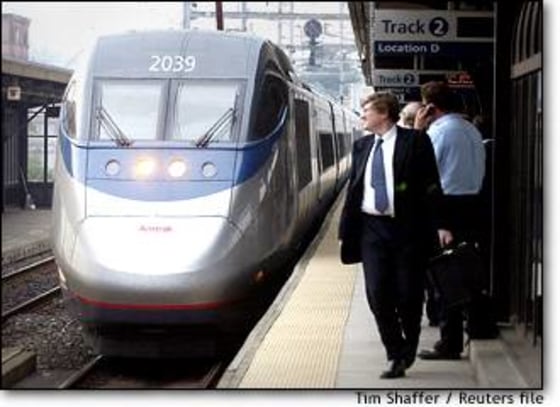Barbara Tedesco is relaxing, listening to a CD player while her 11-year-old son, Tommy, contentedly flips through some books and looks out the window. It’s not the image conjured up by a long trip to a relative’s house — in her case, from Connecticut to Virginia. But for Tedesco and millions of others who ride Amtrak’s intercity trains, this is the pleasant reality.
TEDESCO SAYS making the six-hour trip by train to her sister’s house in Virginia is less of a hassle than flying and more convenient than driving — no traffic and no weather slow-downs to worry about. And, she adds, it’s a lot more child-friendly than a car or plane. “It allows (Tommy) a lot of movement,” she says. “He doesn’t say ‘Are we there yet?’ as often.”
“I get to walk around and there’s food here,” Tommy adds in agreement, before running off to the dining car. “It keeps me busy.”
RECORD NUMBERS
Amtrak’s been busy, too. With many people still shying away from airplane travel since the 9/11 attacks, this should be a golden opportunity for Amtrak to win customers away from the industry that has been its nemesis: the airlines.
Indeed, April, May and June of this year brought the highest ridership numbers for those months in Amtrak’s 32-year history. A particular bright spot is the “Acela Express,” a high-speed service running in the Boston-New York-Washington, D.C. corridor.
But Amtrak officials caution that the railroad is a long way from making a profit. While Amtrak is projecting that it will break even this year, officials say, but the goal set by Congress for the railroad to stop relying on federal funding is described by Amtrak’s spokesman Dan Stessel as “fantasy.”
Stessel and other Amtrak officials cite the huge subsidies the airline industry receive in the form of the federal air traffic system and now the creation of the Transportation Security Administration, which handles airport security. Highways, similarly, they argue, receive billions of dollars a year for construction and maintenance.
And yet, Stessel says, “we have to kind of justify our existence every year.”
At a time when transportation analyst suggest that Amtrak should be thriving and investing in the many high-speed rail corridors being proposed around the country, the railroad’s budget — appropriated each year by Congress — barely keeps the trains running on time. That leaves dreams of high-speed rail to the states, which are facing their own budget crises at the moment.
A POLITICAL FOOTBALL
The annual debate on Amtrak’s budget, once a major ideological target for cuts by fiscal conservatives, has calmed somewhat in recent years. Yet as Congress gets ready to reauthorize the railroad’s funding, there are wide disagreements on Capitol Hill about how much it should get.
Amtrak requested $1.8 billion for 2004, a figure that covers current operations and a five year maintenance program meant to put the railroad’s fleet in good order.
In a reflection of the disagreements that swirl around Amtrak, House and Senate panels that oversee transportation issues approved multi-year funding packages that would see Amtrak get $2 billion annually for at least three years.
But Amtrak enjoys far less support on the powerful appropriations committees, which ultimately determine the amount of money available for individual programs. Last Friday, the House appropriations panel put forth its own figure for Amtrak: $580 million for 2004.
Stessel says that although he knows the discussion is far from over, $580 million is not a sufficient amount of money. “If there is to be an Amtrak in fiscal year 2004, there would have to be more than $580 million,” he says.
But Ernest Istook, Jr. (R-Okla.), a key figure on the House Appropriations subcommittee, says there is not a lot of money to go and what does exist should go primarily to the highway system.
“We put the priority where people are paying the taxes,” Istook says. “Highway users pay their own way and they pay a tax on it. That’s where the greatest need is, and that’s where people are paying their way.”
AN IMAGE PROBLEM
Istook also said the committee had some reservations about Amtrak’s credibility. He said that for years, Amtrak has been promising self-sufficiency but they return every year asking for more money. “That’s been about as reliable as Enron’s bookkeeping,” Istook says.
Warren Flatau, spokesman for the Federal Railroad Administration, agrees that increased funding isn’t the only answer to Amtrak’s problems. He says that while its accountability has been improving as of late, Amtrak needs to do some major restructuring. “Amtrak in its current form may not be the best answer,” Flatau says.
In spite of all the complaints about Amtrak’s structural and monetary problems, frequent train travelers say it’s an essential public service that government needs to maintain.
Maryam and Joseph Donnelly, riding the train to Washington, D.C., say that although they are grateful for the train as a travel option, it’s important that Amtrak concentrate on the routes that are in demand.
“A lot of what’s causing Amtrak to be non-financially productive are the longer routes that no one’s taking that they’re still running,” Maryam Donnelly said. “They tend to be everything to everybody.”
Amtrak figures bear her out, showing that trains in the densely populated northeast corridor are successful, while most long distance trains are money guzzlers. Railroad officials estimate that the loss on Amtrak’s long distance routes ranges from $131 to $551 per passenger.
